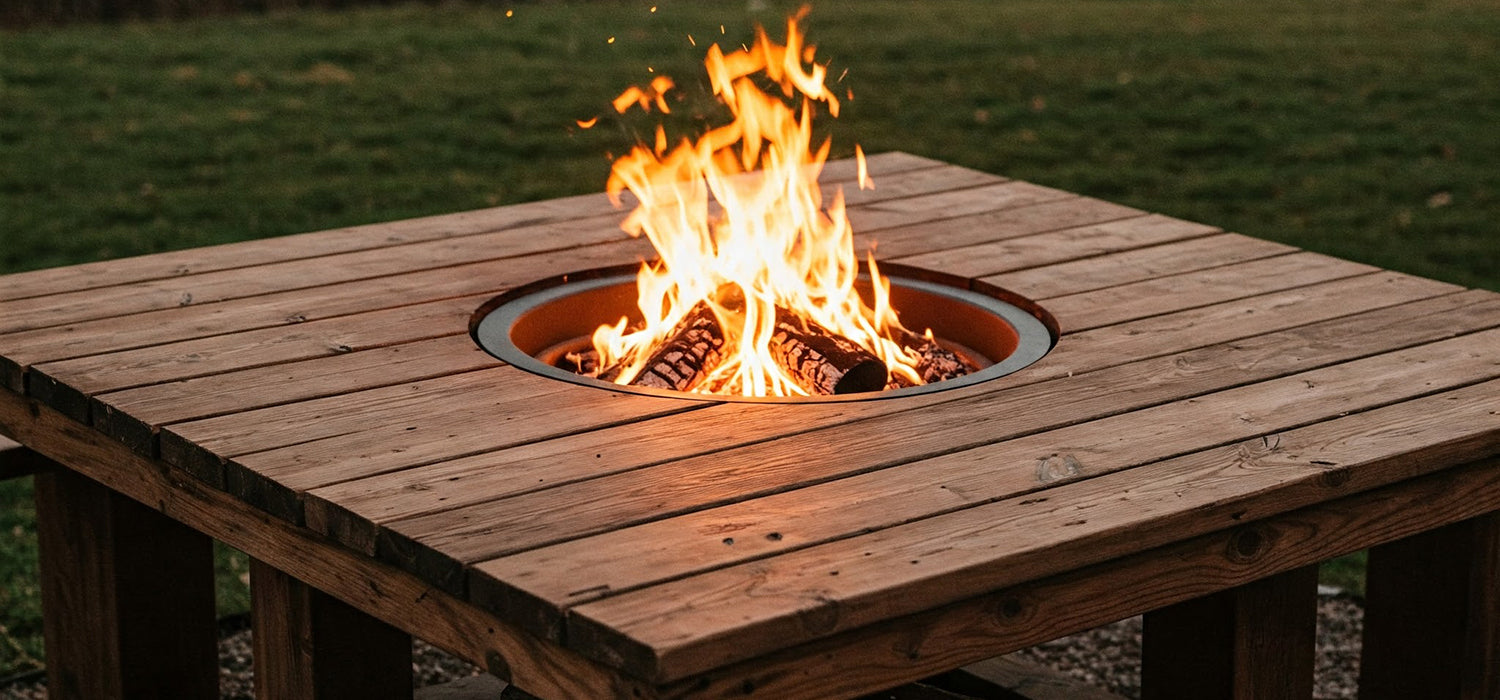
Can You Use a Fire Pit When It’s Windy? (Yes—Here’s How to Stay Safe and Cosy)
Ever tried battling a rogue flame while clutching marshmallows? Wind and fire pits can be a wild combo—but don't cancel your s'mores night just yet. Short answer: Yes, you can use a fire pit when it’s windy—with smart tricks, wind guards, and sturdy Fire Tables. Here's how to do it safely!
Safety Considerations in Windy Conditions
Wind Direction and Speed
Assessing wind direction and potential hazards
Before striking a match, it’s crucial to know which way the wind’s blowing.
If gusts are pushing smoke, sparks, or heat towards your seating area, plants, or (even worse) your house, it’s time to rethink.
Use a simple trick: toss a small handful of dry leaves or grass in the air and watch where they drift.
If they race sideways like a scene from a tornado film, it’s a strong no-go for lighting up.
Always keep flames pointed away from anything valuable—or flammable!
Checking local weather forecasts
A quick check of the weather app could save your evening (and your eyebrows).
If the forecast shows winds stronger than 15 mph, it’s safer to postpone your fire pit plans.
Winds over 20 mph can turn a lovely night into a stressful, ember-chasing event.
And remember—gusts can kick up unexpectedly, even when the forecast looks calm.
Better safe than soggy (or scorched).
Embers and Sparks
Increased risk of fire spread
When the wind gets cheeky, embers love to go on an adventure.
It only takes one tiny, glowing spark to land on a dry leaf, a wooden deck, or your neighbour’s prized rose bush.
The result? A disaster you didn’t RSVP for.
Wind can carry embers surprisingly far, so it’s vital to stay alert when using your fire pit in breezy conditions.
Importance of fire screens and covers
Fire screens and covers are your first line of defence.
A mesh fire screen acts like a bodyguard for your flames, trapping wild sparks before they get ideas.
If you’ve ever tried to swat an ember mid-flight, you’ll know it’s much easier to stop them before they lift off!
Plus, a good cover protects your fire pit when it’s not in use, keeping it safe from sudden gusts and rain showers.
Protective Measures for Windy Conditions
Wind Guards and Shields
Using barriers to block wind
A solid wind guard, especially one made of tempered glass, is a game-changer for gas fire pits and Fire Tables.
It keeps the flame protected while letting you enjoy the view (and your well-earned wine).
If you don’t have a dedicated guard, improvise!
Tall planters, garden screens, or even a strategically parked wheelbarrow can help buffer the breeze.
Adjusting fire pit placement
A small shift can make a big difference.
Move your fire pit to a spot where walls, fences, or even thick shrubs provide natural protection.
Avoid placing it in exposed corners where the wind loves to swoop in and cause trouble.
Sometimes the best seat in the house is the one tucked behind a big, friendly hedge!
Reducing Flame Height
Lowering flame to minimise embers
Big flames might look impressive, but in windy weather, they’re a menace.
If you’ve got a gas fire pit or a Fire Table, turn the flame down low and steady.
It keeps the fire manageable and dramatically reduces the number of embers trying to stage a great escape.
Think of it like turning down the music when the neighbours start peeking over the fence—low and respectful wins the night.
Fire Pit Placement and Orientation
Choosing a Sheltered Location
Avoiding open areas with strong winds
It’s tempting to plonk your fire pit in the middle of your patio to show it off, but open areas are prime targets for wind chaos.
Wind gains speed over flat, open ground, making your fire pit struggle to stay lit—and safe.
Choose corners, alcoves, or spaces close to buildings where the gusts can’t get a clear run.
Your fire will thank you for it (and so will your guests).
Using natural windbreaks
Nature provides some of the best wind protection around.
Tall trees, dense hedges, stone walls, and garden structures like pergolas can all shield your fire from unexpected blasts.
Next time you’re choosing the perfect fire pit spot, think like a fox finding a burrow—tucked away and cosy is the goal.
Alternative Fire Pit Options for Windy Conditions
Enclosed Fire Pits or Chimineas
Providing more protection from wind
If your garden tends to get more breezy than you'd like, it might be time to upgrade.
Enclosed fire pits or traditional chimineas are brilliant choices for windy areas.
They protect the flame inside a sturdy structure, making it much harder for the wind to interfere.
Plus, chimineas bring a rustic charm that’s hard to beat—perfect for that dreamy outdoor evening vibe.
Conclusion
Wind doesn’t have to cancel your fire pit dreams.
By checking the weather, using clever protective gear, choosing sheltered spots, and lowering those flames, you can stay safe and toasty even when the breeze kicks up.
And if you’re tired of chasing flying embers, investing in a quality Fire Table or enclosed pit might just be the best decision you make this year.
A little planning means more toasted marshmallows, fewer firefighting moments—and a lot more evenings spent laughing around the glow of a perfectly tamed fire.
Other content we think you'll love
- Gas Fire Pit for S’mores: Your Guide to Gooey Backyard Treats
- The Ultimate Guide to Choosing a Tabletop Gas Fire Pit
- Gas Fire Pit for Small Patios: The Perfect Solution for Cosy Outdoor Vibes
- Gas Fire Pit for Covered Porch: Enjoy Cozy Warmth All Year Round
- Gas Fire Pit for RV: Your Cosy Companion on the Road
- The Best Portable Gas Fire Pit for Motorhome Camping: A Complete Guide
- The Ultimate Guide to Choosing a Gas Fire Pit for Camping
- Choosing the Perfect Gas Fire Pit for Your Garden
- Are Fire Pit Dining Tables Worth It?
- The Ultimate Guide to Cooking on a Gas Fire Pit
- Are Fire Tables Worth It? Here's What You Need to Know Before Buying
- Are Fire Tables Warm Enough? A Complete Guide to Heat Output
- The Ultimate Guide to Popcorn Making with a Fire Table
- Can You Roast Marshmallows Over a Gas Fire Pit?
- Are Gas Fire Pit Tables Any Good? A Full Guide to Cosy Outdoor Living
- When to Use a Fire Pit: Timing is Everything!

